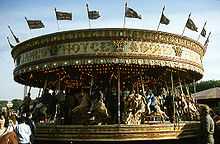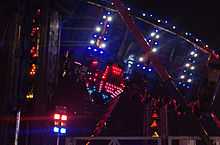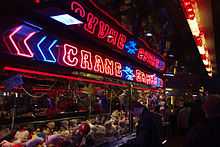Nottingham Goose Fair

The Nottingham Goose Fair is an annual travelling funfair held at the Forest Recreation Ground in Nottingham, England, during the first week of October. It is largely provided by showmen (travelling fair people). It is one of only two established fairs in the United Kingdom to carry the name, the other being the smaller Goosey Fair in Tavistock, Devon.
History
The fair dates back more than 700 years. The consensus among historians is that the fair probably started just after 1284, when the Charter of King Edward I referred to city fairs in Nottingham.[1] The Goose Fair was cancelled due to the bubonic plague in 1646 and again during the two World Wars in the 20th century. 1927 was the last year it was held in Old Market Square in Nottingham City Centre; it was then moved to the Forest Recreation Ground because of redevelopment of the Square.
The Goose Fair started as a trade event and enjoyed a reputation for its high-quality cheese, although it is now known for its rides and games. Its name is derived from the thousands of geese that were driven from Lincolnshire to be sold in Nottingham.
Originally, the fair was held on 21 September, but in 1752, with the change to the Gregorian calendar, it moved to early October. The duration of the fair was shortened from eight days to three days in the 1800s.
Recent history
Nottingham Goose Fair is considered by many people to be one of the most prestigious fairs in the UK. However, in recent years, the dates of the fair have created a problem, as it now overlaps with the Hull Fair. Some of the top rides from the Goose Fair have therefore to travel directly from Nottingham to Hull, not opening at Hull until around the fourth day of the fair. This was averted for 2013 by having Hull Fair start a week later than usual.
It is now held at the Forest Recreation Ground. After the turn of the 21st century its length was increased again to four days, for the 700th anniversary, and was kept like this afterwards. For 2006, the fair increased to five days with the addition of limited opening hours on the Sunday afternoon. However it proved unprofitable to open on the Sunday, so this was not repeated in 2007 although it was opened for 5 days again from 2009.
Goose Fair has seldom been affected by violence, but in 2004, a girl, Danielle Beccan, 14, was fatally shot as she walked home from the Goose Fair through the St. Ann's estate, over a mile from the fair.[2] Following the murder, The Guardian reported that the Goose Fair period was traditionally a time of tension between rival groups, but Danielle herself was not in a gang.[3] Two people were convicted of the murder.[4]
In art and popular culture



The painting Nottingham Goose Fair by Noel Denholm Davis (1910) is held by Nottingham City Museums and Galleries.[5] The Nottingham-based artist Arthur Spooner painted The Goose Fair, Nottingham in 1926.[6][7] The painting was sold at Christie's in 2004[8] and is now displayed in Nottingham Castle.
The book English Journey by J. B. Priestley contains an account of the author's visit to the Goose Fair in 1933. One of Cecil Roberts's books, published in 1928, is called Goose Fair.
The goose fair has been used in television programmes as well as in films such as The Woman for Joe and Saturday Night and Sunday Morning.
The writer D. H. Lawrence would, while living in London between 1908 and 1912, return home to Nottingham every year to visit the Goose Fair.
See also
- Bridgwater
- Tavistock, Devon 'Goosie Fair'
References
- ↑ "History of Goose Fair". Nottingham City Council. Apr 2011. Retrieved 5 October 2011.
- ↑ "Police "baffled" by girl's murder". BBC News. October 2004. Retrieved 8 December 2011.
- ↑ Carter, Helen (October 2004). "A trip to the fair, then a shot rings out and Danielle, 14, is dead". The Guardian. Retrieved 8 December 2011.
- ↑ "Two convicted of Danielle murder". BBC News (BBC News). 12 October 2005. Retrieved 8 December 2011.
- ↑ Your Paintings
- ↑ "About 'The Goose Fair Nottingham'". Teacher Education. The National Gallery, London, UK. Retrieved 20 September 2011.
- ↑ "Notts treasures: Spooner's Goose Fair". Nottingham: Local History. BBC. May 2009. Retrieved 20 September 2011.
- ↑ "Arthur Spooner (1873–1962): The Goose Fair, Nottingham". Christie's, London, UK. Retrieved 20 September 2011.
External links
| Wikimedia Commons has media related to Nottingham Goose Fair. |